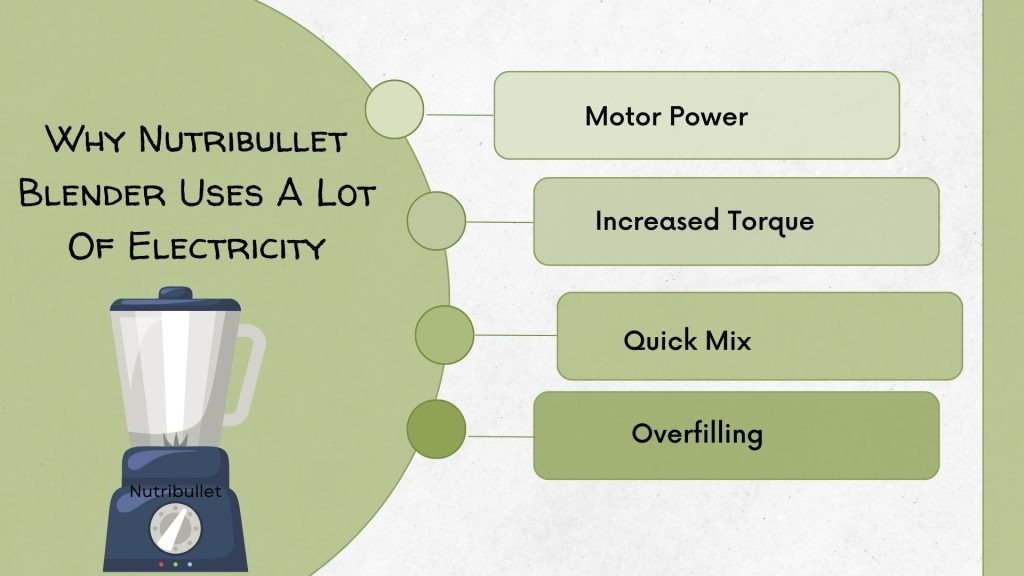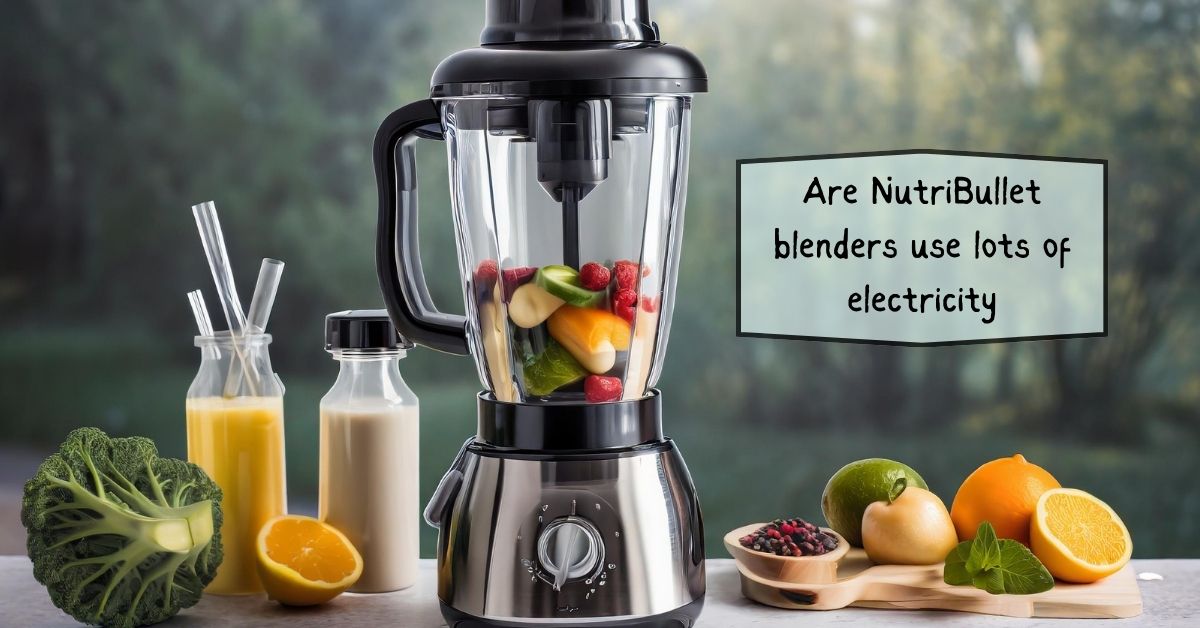Hey, blender buddies and superpowers that fling smoothies! Here’s self-described appliance lover Tammy E. Edison checking in! Is there a sound your NutriBullet produces that you like hearing as you work on your morning masterpiece? Actually, it got me thinking: Is this simply creating sweetness? Or is it using electricity like some kind of monster that has an insatiable appetite?
In this post, I will explain the mysteries of energy use, picking the myths from the milkshake froth. Also, I’ll help you decide if your Nutribullet is an energy-hungry gremlin or a lean, eco-friendly smoothie maker. Now, let’s start mixing!
First of all, I will tell you the reasons why Nutribullet uses electricity.
Why Nutribullet Blender Uses A Lot Of Electricity
Nutribullet blenders might use more electricity than other blenders for a few reasons.

Motor Power
I’ve seen Nutribullet blenders usually have high-powered motors, often from 70 watts to 1500 watts. It is more powerful than many standard blenders. The higher wattage of Nutribullet’s motors increases energy consumption during operation. This results in higher power consumption.
Increased Torque
Nutribullet blenders have higher motor power. This provides increased torque, the rotational force that drives the blades. This enhanced torque allows the blender to handle tougher ingredients. For example, it can blend frozen fruits, seeds, and nuts. But it also requires more electrical energy to maintain the higher level of rotational force.
Read more: How to Clean Nutribullet Blender Blade?
Quick Mix
Nutribullet blenders are actually designed for fast and efficient blending. It often completes the mixing process in 30 to 60 seconds. This is convenient for quick mixing. This means the motor is able to run at full power for a shorter period than a traditional blender. I have noticed that a traditional blender takes 1-2 minutes to blend the same ingredients. While the total mixing time is shorter, the Nutribullet’s motor works harder during that time. As a result, more electricity is consumed.
Overfilling
Another thing I have noticed is that the blender makes noise due to overfilling. The effect on the motor then consumes more electricity. But there are several reasons why blenders make excessive noise. Do you know what they are? I have a post about “why the Nutribullet blender makes a loud noise.
Now you know four reasons why it uses more electricity. Next, you will know the wattage required by a NutriBullet.
How much wattage does a NutriBullet use?
The wattage of a NutriBullet varies depending on the specific model you have. Here’s a breakdown of some popular models:
| Blender Model | Wattage |
| NutriBullet GO Cordless | 70 watts |
| Original NutriBullet | 600 watts |
| NutriBullet Slim | 600 watts |
| NutriBullet Pro | 900 watts |
| NutriBullet® Pro 1000 | 1000 watts |
| NutriBullet Blender Combo | 1200 watts |
| Nutribullet® Blender | 1200 watts |
| Nutribullet® Smart Touch Blender | 1500 watts |
NutriBullet GO Cordless: 70 watts. This portable model is battery-powered. It’s perfect for traveling or mixing on the go. It comes with a single-serving cup with a leak-proof lid.
Last year, when I went to Cape Hatteras Beach in Newark, I used “Nutribullet GO.” It was really awesome!
Original NutriBullet: 600 watts. This is the classic model, perfect for simple smoothies and shakes in single servings. For example:
- Soft fruits: berries, bananas, peaches, mangoes, and melon
- Leafy greens: spinach, kale, and romaine lettuce
- Sturdier vegetables: carrots, cucumber, celery, and beets (cut into smaller pieces).
- Water, milk (dairy or plant-based), yogurt, coconut water, and juice
- Nut butters (add a little liquid to avoid the motor getting overworked)
NutriBullet Slim: 600 watts. Similar to the original NutriBullet but with a sleeker design and a single 24-ounce cup.
NutriBullet Pro: 900 watts. This model is more powerful than the original. It can handle tougher ingredients like nuts and celery. It comes with two 32-ounce cups and additional accessories.
The Nutribullet® Pro 1000 is perfect for smoothies. It can handle both soft and tough ingredients. With its upgraded blades and a strong 1000-watt motor, it’s now easier to whip up silky-smooth superfood smoothies.
NutriBullet Blender Combo: 1200 watts. This model combines the power of a full-size blender. It also has the convenience of single-serving cups. It comes with a 64-ounce pitcher and two 24-ounce cups.
The Nutribullet® Blender has increased power to 1200 watts. It comes with improved control, offering three speeds and a pulse option. It also has expanded capacity to make more tasty and nutritious blends. The 64-oz blender pitcher has a vented lid. This allows you to blend hot ingredients and quickly create warm soups seamlessly. This blender is an ideal choice for preparing larger servings. It is perfect for parties or gatherings.
Nutribullet® Smart Touch Blender. It boasts 1500 watts of power. It can switch between single-serve and multi-serve blending. It’s robust and versatile. It’s ready to handle any culinary creation. The sleek touchscreen display and intelligent programs are tailored for various scenarios. They make using it a delightful experience. The culinary possibilities are boundless.
Which Nutribullet Blender is Right for You?
I need a little more information about your needs and preferences. Then, I can recommend the best NutriBullet for you. Here are some questions to consider:
How will you be using the blender?
- Mainly for single-serve smoothies and shakes?
- Do you need to blend tough ingredients like nuts, ice, or frozen fruit?
- Do you want to blend larger batches for families or gatherings?
- Portability is important.
What’s your budget?
What features are important to you?
- Do you need multiple speeds and settings?
- Are easy-cleaning and dishwasher-safe parts important?
- Do you prefer a sleek and compact design or a larger capacity?
Based on your answers, here are my recommendations:
- Best for simple smoothies and shakes (single-serve): Original NutriBullet (600 watts) or NutriBullet Slim (600 watts).
- Best for tougher ingredients and larger batches: NutriBullet Pro (900 watts) or NutriBullet Blender Combo (1200 watts).
- Best for portability: NutriBullet GO Cordless (70 watts).
- Best for large families or gatherings: Nutribullet® Blender (1200 watts).
- Best for advanced features and versatility: Nutribullet® Smart Touch Blender (1500 watts).
Conclusion
Finally, I have to say that Nutribullet blenders are designed to be energy-efficient but consume a bit more electricity. However, the exact power consumption depends on the model and usage patterns. The power consumption is high for the four reasons that I mentioned above. To reduce energy consumption, use the blender correctly.
Hopefully, I have gotten to know you in detail from today’s discussion. Thanks for staying with me. Please let us know in the comment box if you have any feedback about the Nutribullet Blender.
As a 10 years veteran in the culinary industry, I have developed a passion for all things kitchen. With a deep understanding of food preparation and cooking techniques, I am a true kitchen specialist. My experience working in Khedmot kitchen has allowed me to hone my skills and become an expert in creating delicious and visually appealing dishes.
I am a creative and innovative chef, constantly experimenting with new ingredients and cooking methods to bring unique and memorable dining experiences to my customers. In addition to my culinary expertise, I am also highly organized and able to effectively manage a team of kitchen staff, ensuring that all tasks are completed efficiently and to a high standard.
I am dedicated to my craft and always strive to create exceptional dining experiences for my customers. Whether it’s developing a new menu, training my kitchen team, or working with local suppliers, I am always looking for ways to improve and take my kitchen to the next level.
If you’re looking for a skilled and passionate kitchen specialist, look no further. I am eager to bring my expertise to your team and help take your kitchen to the next level.


